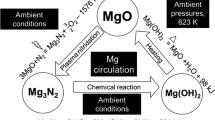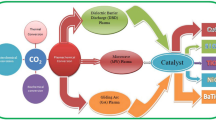Abstract
The rapid deployment of solar and wind technology produces significant amount of low-quality electricity that calls for a better storage or usage instead of being discarded by the grid. Instead of electrochemical CO2 reduction and/or NH3 production, here we propose that non-thermal plasma oxidation of N2 into nitrate or other valuable nitrogen containing compounds deserve more research attention because it uses free air as the reactant and avoids the solubility difficulty, and also because its energy consumption is merely 0.2 MJ/mol, even lower than the industrially very successful Haber–Bosch process (0.48 MJ/mol) for NH3 production. We advocate that researchers from the plasma community and chemistry community should work together to build energy efficient non-thermal plasma setup, identify robust, active and low-cost catalyst, and understand the catalyzing mechanism in a plasma environment.We are confident that free production of nitrate with zero CO2 emission will come true in the near future.
Similar content being viewed by others
References
Lund H, Munster E. Management of surplus electricity-production from a fluctuating renewable-energy source. Applied Energy, 2003, 76(1–3): 65–74
Lv W, Zhang R, Gao P, Lei L. Studies on the faradaic efficiency for electrochemical reduction of carbon dioxide to formate on tin electrode. Journal of Power Sources, 2014, 253: 276–281
Zhou F, Azofra L M, Ali M, Kar M, Simonov A N, McDonnell-Worth C, Sun C, Zhang X, MacFarlane D R. Electro-synthesis of ammonia from nitrogen at ambient temperature and pressure in ionic liquids. Energy & Environmental Science, 2017, 10(12): 2516–2520
Thomas H. The Alchemy of Air: A Jewish Genius, A Doomed Tycoon, and The Scientific Discovery That Fed The World But Fueled The Rise Of Hitler. 1st ed. New York: Harmony Books, 2008
Schrock R R. Reduction of dinitrogen. Proceedings of the National Academy of Sciences of the United States of America, 2006, 103 (46): 17087
Erisman J W, Sutton M A, Galloway J, Klimont Z, Winiwarter W. How acentury of ammonia synthesis changed the world. Nature Geoscience, 2008, 1(10): 636–639
Cherkasov N, Ibhadon A O, Fitzpatrick P. A review of the existing and alternative methods for greener nitrogen fixation. Chemical Engineering and Processing, 2015, 90: 24–33
Kipouros G J, Sadoway D R. Toward new technologies for the production of lithium. JOM, 1998, 50(5): 24–26
Appl M. The Haber–Bosch heritage: the ammonia production technology. In: Proceedings of 50th Anniversary IFA Technical Conference, 1997, 25
Legasov V A, Rusanov V D, Fridman A A. Non-equilibrium plasma-chemical processes in heterogeneous media. Plasma Chemistry, 1978, 5: 222–241
Rusanov V D, Fridman A A, Sholin G V. The physics of a chemically active plasma with nonequilibrium vibrational excitation of molecules. Soviet Physics-Uspekhi, 1981, 24(6): 447–474
Mccollum E D, Daniels F. Experiments on the arc process for nitrogen fixation. Industrial & Engineering Chemistry, 1923, 15(11): 1173–1175
Partridge W S, Parlin R B, Zwolinski B J. Fixation of nitrogen in a crossed discharge. Industrial & Engineering Chemistry, 1954, 46(7): 1468–1471
Rahman M, Cooray V. NOx generation in laser-produced plasma in air as a function of dissipated energy. Optics & Laser Technology, 2003, 35(7): 543–546
Namihira T, Katsuki S, Hackam R, Akiyama H, Okamoto K. Production of nitric oxide using a pulsed arc discharge. IEEE Transactions on Plasma Science, 2002, 30(5): 1993–1998
Wang W, Patil B, Heijkers S, Hessel V, Bogaerts A. Nitrogen fixation by gliding arc plasma: better insight by chemical kinetics modelling. ChemSusChem, 2017, 10(10): 2145–2157
Patil B. Plasma (catalyst)-assisted nitrogen fixation: reactor development for nitric oxide and ammonia. Eindhoven: Technische Universiteit Eindhoven, 2017, 93–125
Holland P L. Metal–dioxygen and metal–dinitrogen complexes: where are the electrons? Dalton Transactions (Cambridge, England), 2010, 39(23): 5415–5425
Acknowledgements
This work was financially supported by the National Natural Science Foundation of China (Grant No. 61725401) and the National Key R&D Program of China (No. 2016YFA0204000). We also thank Junye Zhang from School of Optical and Electronic Information, Huazhong University of Science and Technology, and Sai Tu from College of Chemistry and Molecular Science, Wuhan University for helpful discussions.
Author information
Authors and Affiliations
Corresponding author
Additional information
Yi He is currently an undergraduate student in Department of Optical and Electronic Information, Huazhong University of Science and Technology, Wuhan, China. Her research interests include optoelectronic devices and physical optics.
Zhengwu Chen received his B.S. degree from Huazhong university of Science and Technology in 2012 and currently works as a second-year graduate student at Wuhan National Laboratory for Optoelectronics. His researches are related to semiconductor devices and optical spectroscopy.
Zha Li received his B.S. degree in Chemistry from Fudan University and Ph.D. degree of engineering in Bio-informatics in Tokyo Institute of Technology, Tokyo, Japan, in 2013. He joined the Wuhan National Laboratory for Optoelectronics, Huazhong University of Science and Technology as a postdoctoral researcher.
Guangda Niu is an associate Professor at Wuhan National Laboratory for Optoelectronics, Huazhong University of Science and Technology, Wuhan, China. He is working on synthesis of metal halide perovskite semiconductors and their applications in optoelectronic devices.
Jiang Tang is a full professor at Wuhan National Laboratory for Optoelectronics, Huazhong University of Science and Technology. He graduated from University of Toronto in 2010 and have received the NSFC research funds for exceptional young scholars. His current research interest is exploring new semiconductor materials for optoelectronic devices.
Rights and permissions
About this article
Cite this article
He, Y., Chen, Z., Li, Z. et al. Non-thermal plasma fixing of nitrogen into nitrate: solution for renewable electricity storage?. Front. Optoelectron. 11, 92–96 (2018). https://doi.org/10.1007/s12200-018-0807-z
Received:
Accepted:
Published:
Issue Date:
DOI: https://doi.org/10.1007/s12200-018-0807-z




